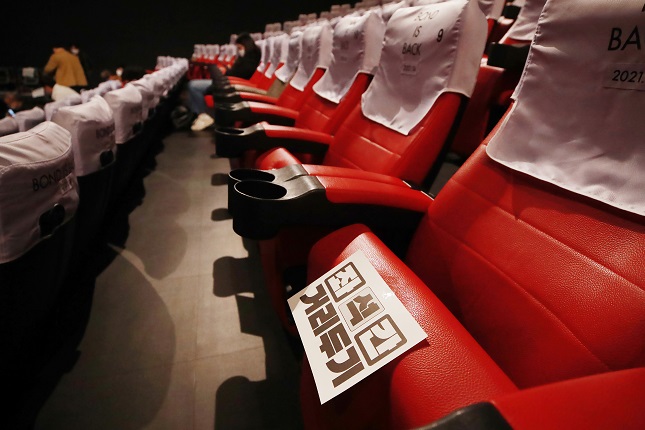SEOUL, Feb. 18 (Korea Bizwire) — Kim Eun-hee, 41, is a casual moviegoer who would normally go to theaters once or twice a month to hang out with friends on weekends.
But last year, she never once went to the cinema, partly out of fears of possibly being infected with the novel coronavirus in a closed and confined public environment.
“I’ve been staying at home every weekend for about a year, and movie theaters are one of the first places that I stopped going,” she said.
“Instead, Netflix provides enough films and shows to help me forget my habitual experiences at theaters. I’m watching more movies than I did before.”
Kim’s case clearly represents the current dilemma that the South Korean film industry faces and what appears to be growingly ominous future that industry insiders are afraid of.
As casual movie fans such as Kim increasingly abandoned cinemas last year, South Korea’s box office saw a whopping 73.7 percent on-year plunge in terms of the number of moviegoers, from 226.7 million for 2019 to 59.5 million in 2020, according to the Korean Film Council (KOFIC).
The industry’s total revenue in 2020 also plummeted 73.3 percent to 510.4 billion won (US$460.6 million) from 1.9 trillion won the previous year.

This file photo taken on Oct. 28, 2020, shows signs urging social distanced seating at a movie theater in Seoul. (Yonhap)
Instead, people have increasingly rushed to streaming services like Netflix.
The U.S. company saw its monthly unique visitors in South Korea surge 64.2 percent between January and November of last year, seeing substantial growth in users during the course of the pandemic.
Wavve, a content streaming service launched by South Korea’s terrestrial broadcasters, including KBS, posted a 22 percent gain in monthly active users last year, while subscribers to No. 3 Tving, owned by entertainment giant CJ Group, also jumped 59 percent on-year.
Experts point out that this trend is actually not a fad attributed solely to the pandemic. A big shift in the platform industry has been sweeping the entertainment industry for years and the COVID-19 pandemic just fueled that pace in 2020.
“The film industry is based on its own platform of cinema, and it is consequently affected by the shift in platform to a great degree,” said a recent KOFIC report on the state of the film industry released last December.
“The COVID-19 pandemic has accelerated the trend.”
Netflix, in particular, rose to be a new dominant trendsetter in the South Korean entertainment industry in 2020, just three years after it made a splash by financing director Bong Joon-ho’s 2017 adventure film “Okja.”
The American streaming giant, which has funneled nearly 800 billion won into Korean projects, especially TV series, since its Korean market debut in 2015, has been initiating bold projects in the virus-hit film production industry in the country.
It bought the distribution rights of five Korean films, including “Time To Hunt,” “Call” and “Space Sweepers,” and has released them on its platform without theatrical runs since last year.
Furthermore, some industry pessimists forecast that the pandemic-induced contactless trend could potentially lead to the dismantling of the traditionally close-knit industry ties between filmmakers, distributors and theaters and usher in an era of a direct, binary relationship between film producers and Netflix.
“Society has been already moving toward zero-contact settings,” Prof. Jeong Min-ah from Sungkyul University wrote in her latest industry analysis paper.
“We are at a crossroads of the trend that the mainstream way of watching movies will be replaced amid the disappearance of theaters and the emergence of new platforms.”
Some culture critics predict that the film industry may no longer see theaters packed with film buffs, couples and families during weekends.
In reality, theaters nowadays are increasingly seen as intimate, boutique venues for hardcore movie fans or old cinephiles who are willing to enjoy delicate, award-winning titles or art house films.
“The younger generation got familiar with watching content through smartphones on the couch or bed. They don’t agree that films have to be seen in a dark theater without interruptions,” culture critic Kim Seong-soo said.
“Many doubt that they would come to theaters and pay for a film to watch on an uncomfortable seat even after the pandemic.”
But he said theaters can still be compatible with new platforms by targeting a niche market for people who want special experiences that smartphone content cannot offer.
For example, the global sensation “Harry Potter” series has been re-released on the big screen in a “4DX” version that offers moviegoers an augmented viewing experience, including moving seats, wind, water, lights and scents.
The 4DX-enhanced version of “Harry Potter and The Goblet of Fire,” re-released on Feb. 10 this year, ranked fifth on South Korean box office last weekend, despite its limited screenings.
“Theaters have bigger screens with exceptional sound quality compared to mobile phones or TV sets at home,” said Hwang Jae-hyun, a representative at CJ CGV, South Korea’s leading multiplex chain.
“And we are trying to create cozy and comfortable environments by widening spaces and putting more cushions to help people feel at home.”
(Yonhap)








